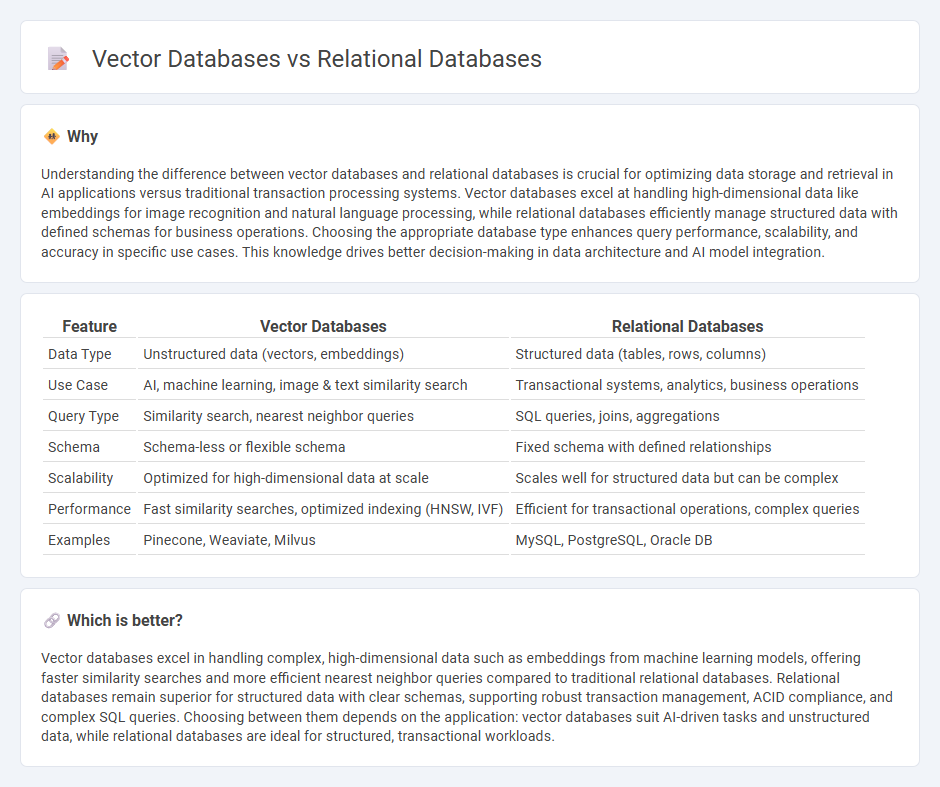
Vector databases excel in handling high-dimensional data and supporting complex similarity searches, making them ideal for AI applications and recommendation systems. Relational databases are optimized for structured data with predefined schemas and excel in transactional consistency and complex querying using SQL. Explore the differences in performance, scalability, and use cases to determine which database best suits your technology needs.
Why it is important
Understanding the difference between vector databases and relational databases is crucial for optimizing data storage and retrieval in AI applications versus traditional transaction processing systems. Vector databases excel at handling high-dimensional data like embeddings for image recognition and natural language processing, while relational databases efficiently manage structured data with defined schemas for business operations. Choosing the appropriate database type enhances query performance, scalability, and accuracy in specific use cases. This knowledge drives better decision-making in data architecture and AI model integration.
Comparison Table
| Feature | Vector Databases | Relational Databases |
|---|---|---|
| Data Type | Unstructured data (vectors, embeddings) | Structured data (tables, rows, columns) |
| Use Case | AI, machine learning, image & text similarity search | Transactional systems, analytics, business operations |
| Query Type | Similarity search, nearest neighbor queries | SQL queries, joins, aggregations |
| Schema | Schema-less or flexible schema | Fixed schema with defined relationships |
| Scalability | Optimized for high-dimensional data at scale | Scales well for structured data but can be complex |
| Performance | Fast similarity searches, optimized indexing (HNSW, IVF) | Efficient for transactional operations, complex queries |
| Examples | Pinecone, Weaviate, Milvus | MySQL, PostgreSQL, Oracle DB |
Which is better?
Vector databases excel in handling complex, high-dimensional data such as embeddings from machine learning models, offering faster similarity searches and more efficient nearest neighbor queries compared to traditional relational databases. Relational databases remain superior for structured data with clear schemas, supporting robust transaction management, ACID compliance, and complex SQL queries. Choosing between them depends on the application: vector databases suit AI-driven tasks and unstructured data, while relational databases are ideal for structured, transactional workloads.
Connection
Vector databases and relational databases are connected through their complementary roles in managing and querying data; vector databases excel in handling high-dimensional data such as embeddings generated from AI models, while relational databases efficiently store structured data with defined schemas. Integration between the two allows seamless querying of unstructured data alongside structured records, enhancing applications like recommendation systems, search engines, and analytics. Technologies such as hybrid query engines and middleware enable this connection by translating vector similarity searches into relational queries and vice versa.
Key Terms
Schema (Relational)
Relational databases rely on a structured schema that defines tables, columns, data types, and relationships, enabling efficient data organization and integrity enforcement through constraints like primary keys and foreign keys. This fixed schema requires predefining the data model, ensuring consistent and optimized querying via SQL. To explore how schema impacts performance and flexibility in different database types, discover more here.
Embeddings (Vector)
Relational databases organize data into structured tables with predefined schemas, making them ideal for transactional systems but less efficient at handling unstructured data like embeddings. Vector databases specialize in storing and querying high-dimensional vector data generated from embeddings, enabling fast similarity searches and machine learning applications such as recommendation systems and natural language processing. Explore how integrating vector databases with embeddings transforms AI-driven data retrieval and analysis.
Query Language
Relational databases utilize Structured Query Language (SQL) to perform precise operations on well-defined, tabular data, enabling complex joins and aggregations. Vector databases, designed for high-dimensional data like embeddings, rely on similarity search algorithms rather than traditional query languages, often integrating APIs that support approximate nearest neighbor (ANN) queries. Explore the differences in query capabilities to choose the best fit for your data-driven applications.
Source and External Links
What is a Relational Database? - Amazon Web Services (AWS) - A relational database is a set of data points organized in tables with predefined relationships, allowing data to be accessed in multiple ways by joining tables and easily uncovering connections between different data points.
What Is A Relational Database (RDBMS)? | Google Cloud - Relational databases store information in one or more tables of rows and columns, with data from different tables linked through common attributes to enable insightful analysis of how different data structures relate to each other.
What is a Relational Database? - IBM - This type of database organizes data into rows and columns within tables, where relationships between tables are maintained through primary and foreign keys, and SQL queries are used to analyze and report on data across multiple tables.
 dowidth.com
dowidth.com